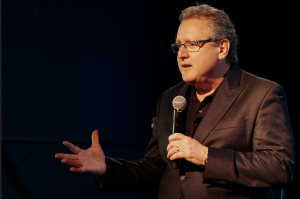
By Mark W. Schaefer
When I started on Twitter in 2008, it was THE cool place to connect, share ideas, and meet new people. I would hang out there in the evenings and have amazing conversations with new friends from all around the globe.
And then, it got crowded.
My precious little band of followers ballooned to hundreds, thousands, and tens of thousands.
Brands caught on, flooding the Twittersphere with their own weird idea of customer engagement.
The amount of content on Twitter literally exploded. It was nearly impossible to keep up with anything.
This is Content Shock in an intimate setting … my setting. As the amount of content dramatically increased and my attention span remained finite, my ability to engage on Twitter declined, and it was more difficult for anybody to get my attention there. My social media engagement level was still the same, it just became diluted.
Fast forward to 2015. This is when Snapchat became the new media darling and one of the reasons was “engagement is through the roof.” But that engagement level isn’t sustainable, is it? Eventually Snapchat will become Twitter-fied. This week I heard this comment: “I am really pissed that I am seeing ads in between the stories of my friends. Snapchat is getting cluttered and I hate that.”
Counting on a long-term, high customer engagement level on Snapchat (or anywhere) as a business case is foolish because it probably can’t last, and we’re already seeing proof of that.
Here is a question I received on a podcast interview this week: Should our listeners be on Facebook Live? Isn’t that where the customer engagement will be?
Mark Zuckerberg is certainly pushing live video streaming aggressively and predicted that one day soon MOST of the Facebook news stream would consist of live videos.
Personally, I can think of nothing more horrifying. It’s simply the next opportunity for Content Shock. Am I really going to sit there and watch video after video after video? Too much, too much, too much.
Almost every company and brand wants to encourage engagement. So what should we do to achieve that in a noisy world?
The real story of customer engagement
When I write a blog post people love, I still get a ton of engagement on Twitter. I get comments on my blog. I may even get an email with an observation or a question about what I wrote.
Sometimes, I publish my blog posts on Facebook, LinkedIn and Medium, prompting more questions and comments.
There is even a rare occasion when an outstanding article makes the cut and is published on Harvard Business Review, where I get still more engagement.
The point is, customer engagement will occur where your fans want it to happen, not where you want it to happen. I’m not sure you can manufacture a customer engagement strategy that includes a specific platform because over time, that is not sustainable. Your fans will naturally migrate to wherever they want to be.
A better question …
Perhaps we’re asking the wrong question. Maybe it doesn’t matter if we’re on Snapchat or Facebook Live. What matters most is where our customers want to be found, where they want to engage.
Here’s an example.
I was doing a project for a company in the gaming industry. They had embarked on a social media strategy that included all the usual suspects — Facebook, Twitter, Google+, etc. But they were frustrated because they weren’t getting any engagement at all.
Problem was, when I helped them research their problem, they were engaging in the wrong places. Their customers were hanging out in chatrooms, forums, and a few fan blogs, not Facebook. So by going to where the fans are (and not in a creepy way) we were able to craft a much more satisfying plan.
Does this seem like common sense? Perhaps, but often I see strategies based on what we think we should do, instead of what our customers want us to do … and I think that is the best consideration when trying to improve customer engagement.
There are many other strategies to combat information density (which I outline in The Content Code book) but I think the first step is to have reasonable expectations about the level of engagement we can sustain when a channel is becoming popular.
What do you think? (A request for engagement!)
 Mark Schaefer is the chief blogger for this site, executive director of Schaefer Marketing Solutions, and the author of several best-sellingdigital marketing books. He is an acclaimed keynote speaker, college educator, and business consultant. The Marketing Companion podcast is among the top business podcasts in the world. Contact Mark to have him speak to your company event or conference soon.
Mark Schaefer is the chief blogger for this site, executive director of Schaefer Marketing Solutions, and the author of several best-sellingdigital marketing books. He is an acclaimed keynote speaker, college educator, and business consultant. The Marketing Companion podcast is among the top business podcasts in the world. Contact Mark to have him speak to your company event or conference soon.
Illustration courtesy Flickr CC and Boston Public Library


